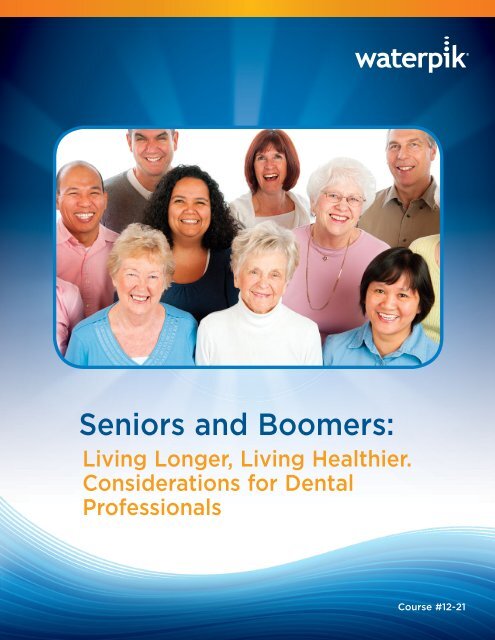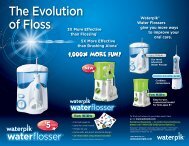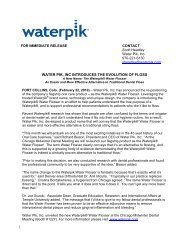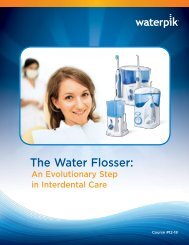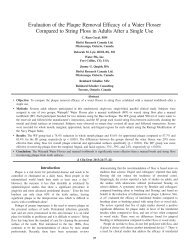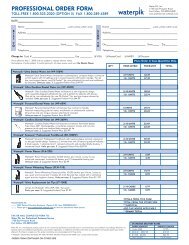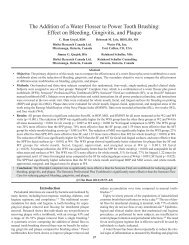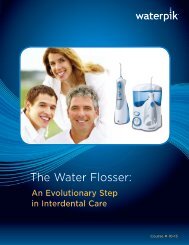Seniors and Boomers: Living Longer, Living Healthier ... - Waterpik
Seniors and Boomers: Living Longer, Living Healthier ... - Waterpik
Seniors and Boomers: Living Longer, Living Healthier ... - Waterpik
Create successful ePaper yourself
Turn your PDF publications into a flip-book with our unique Google optimized e-Paper software.
<strong>Seniors</strong> <strong>and</strong> <strong>Boomers</strong>:<br />
<strong>Living</strong> <strong>Longer</strong>, <strong>Living</strong> <strong>Healthier</strong>.<br />
Considerations for Dental<br />
Professionals<br />
Course #12-21
Disclosure Statement:<br />
• The content for this self-study course was developed <strong>and</strong><br />
written by Water Pik, Inc. employee Carol A. Jahn, RDH, MS.<br />
• This course was designed, developed, <strong>and</strong> produced by<br />
Water Pik, Inc.<br />
• Water Pik, Inc. manufactures <strong>and</strong> distributes products<br />
addressed in this course.<br />
Course Objective:<br />
To provide the dental team with research <strong>and</strong> information<br />
to underst<strong>and</strong> <strong>and</strong> recognize the overall health needs <strong>and</strong><br />
expectations of baby boomers <strong>and</strong> senior citizens <strong>and</strong> provide<br />
them with quality care <strong>and</strong> patient service.<br />
Learning Outcomes:<br />
• Underst<strong>and</strong> the societal <strong>and</strong> social impact of aging.<br />
• Identify the chronic diseases, conditions, <strong>and</strong> disabilities<br />
affecting those over age 50.<br />
• Discuss how chronic disease <strong>and</strong> disability may impact oral health.<br />
• Recognize how physical limitations affect daily self-care<br />
<strong>and</strong> make appropriate recommendations.<br />
INTRODUCTION<br />
Every eight seconds, someone in US turns 50. People over the<br />
age of 65 exceed 35 million. By 2050, that number is expected<br />
to be 89 million. Influenced by the US baby boom that occurred<br />
between 1946 <strong>and</strong> 1964 followed by lower fertility rates especially<br />
in Europe, for the first time, globally, those over age 65 will soon<br />
outnumber those under the age of 5. 1 In the United States, data<br />
from the 2010 census indicate that the senior demographic is<br />
increasing faster than younger populations, making one out of<br />
every nine Americans “old” (over age 65). 1<br />
This larger aging population is leaving its mark on a culture that has<br />
long emphasized youth. So-called boomers are better educated <strong>and</strong><br />
healthier than previous generations. They will likely spend 20–25% of<br />
their lives in retirement, <strong>and</strong> many will continue to desire an active<br />
<strong>and</strong> intellectually stimulating lifestyle. 1 The good news is that this is a<br />
likely <strong>and</strong> reasonable expectation. Findings demonstrate that levels<br />
of mortality <strong>and</strong> other indicators of health that used to exist at age<br />
70 now occur at age 80; <strong>and</strong> those that used to prevail at age 80<br />
appear at age 90. 2 So, not only are people living longer, but people<br />
are living longer in better health.<br />
BOOMING NUMBERS OF<br />
SENIORS: IMPACT ON SOCIETY<br />
The concept of retirement will likely be different for boomers.<br />
Many expect to continue working past age 65; at least half indicate<br />
they expect to work part-time following retirement. 1 They will likely<br />
have more discretionary income. Few will be in nursing homes;<br />
more will choose active retirement communities. Non-Hispanic<br />
whites make up more than 80% of the older population; by 2030<br />
the number is expected to decrease to 72%. 3<br />
Another dimension of the aging population is the number of<br />
people living to ages 90 <strong>and</strong> beyond. The older population<br />
is now subcategorized into three demographics; “young-old”<br />
(65–74), “old” (74–85), <strong>and</strong> the fastest-growing segment referred<br />
to by some as the “oldest old” or the “super elderly” (85+). 15<br />
Centenarians, or those age 100 <strong>and</strong> above, now number more<br />
than 55,000, <strong>and</strong> this number is increasing daily. About 80% are<br />
women. 3 Data now indicate that many of the oldest old have<br />
health profiles that are similar to those 7–8 years younger, allowing<br />
them to avoid disability <strong>and</strong> lead healthy, independent lives. 5<br />
Data indicate that many of the<br />
oldest old have health profiles that are<br />
similar to those 7–8 years younger<br />
allowing them to avoid disability<br />
Work Life<br />
Better health, higher levels of education, economic changes,<br />
knowledge work versus physical labor, availability of health<br />
insurance, increased prevalence of retirement savings plans (401K)<br />
versus pensions, <strong>and</strong> eligibility for social security benefits mean<br />
that more older individuals are choosing to stay in the work force<br />
longer. 3,6 Between 2003 <strong>and</strong> 2010, the fastest-growing labor<br />
force group was comprised of people ages 55 to 64. By the year<br />
2020, when all baby boomers will be 55 years old or older, the<br />
percentage of workers age 55 <strong>and</strong> up is projected to be over 20%,<br />
an anticipated 8% increase from 2000. The enjoyment of working<br />
<strong>and</strong> the feeling of usefulness are the most common reasons for<br />
staying employed. 3<br />
Not only are older workers choosing to transition into retirement<br />
rather than cease working completely, employers are encouraging<br />
older workers to stay in the workforce by offering flexible hours,<br />
fewer days, or even working a part-year schedule. 6 More older<br />
individuals than younger choose self-employment or alternative<br />
employment including independent contracting, on-call work,<br />
temporary help, or contractual agreements. 3 Senior citizens who<br />
stay in the workforce are twice as likely as their non-working<br />
counterparts to report that they are in very good to excellent<br />
health. In fact, those who retire at an early age—between 50 <strong>and</strong><br />
58—are the most likely group to report poor health as the primary<br />
reason for retirement. Older workers also report higher levels of<br />
education <strong>and</strong> greater prosperity. 3<br />
Home Life<br />
<strong>and</strong> lead healthy, independent lives. 5<br />
About 80% of people over the age of 65 own their own homes.<br />
Most do not move, preferring to grow old near children/<br />
gr<strong>and</strong>children. The percentage of older people living in a nursing<br />
home has been declining since 1990. In 2000, only 4.5% of those<br />
age 65 <strong>and</strong> older lived in this type of facility. Both improved<br />
health <strong>and</strong> increasing options for long-term care play a role in<br />
2
an older person’s decision to live independently. Assisted living,<br />
which allows people to have more privacy <strong>and</strong> independence<br />
yet provides some personal <strong>and</strong> nursing services as needed, is<br />
increasingly popular as are residential care facilities. Residential<br />
facilities have various levels of care in close proximity allowing<br />
people to move between arrangements as needed. 3<br />
With increasing age, living in a nursing home becomes more<br />
likely; currently, about 18% of those over 85 years reside in one.<br />
The majority (41.7%) of seniors living in a nursing home are<br />
women over age 85. Male nursing home residents are generally<br />
younger, possibly because they have higher rates of serious <strong>and</strong>/<br />
or permanent injuries at a younger age. 3<br />
CHRONIC CONDITIONS:<br />
MEDICALLY COMPLEX<br />
AND COMPROMISED<br />
As people live longer, the prevalence of disease, especially chronic<br />
disease including heart disease, chronic obstructive pulmonary<br />
disease (COPD), diabetes, <strong>and</strong> arthritis, increases. 4 Improved<br />
screenings leading to earlier detection, coupled with more effective<br />
treatments, have decreased suffering, disability, <strong>and</strong> mortality. 2,5<br />
This is evidenced by the fact that the US mortality rate continues<br />
to decline as life expectancy (now 78.7) increases. More people are<br />
living to age 65, <strong>and</strong> those who do have more years remaining than<br />
people did a century ago. 3<br />
The top four leading causes of death in older individuals are heart<br />
disease, cancer, stroke, <strong>and</strong> COPD. 3 Heart disease <strong>and</strong> cancer<br />
account for nearly half of all deaths. Diabetes <strong>and</strong> Alzheimer’s<br />
disease also are responsible for a significant number of deaths in<br />
seniors. In 2007, Alzheimer’s disease <strong>and</strong> diabetes switched places,<br />
with Alzheimer’s disease now the sixth leading cause of death <strong>and</strong><br />
diabetes the seventh. 7<br />
Heart Disease <strong>and</strong> Stroke<br />
Cardiovascular disease (CVD) is responsible for more deaths in the<br />
United States than any other cause; it claims more lives each year<br />
than cancer, lower respiratory diseases, <strong>and</strong> accidents combined. It<br />
is the leading cause of death in both men <strong>and</strong> women, accounting<br />
for one in every three deaths <strong>and</strong> approximately one death every<br />
39 seconds. Thirty-three percent of CVD deaths occur before<br />
age 75. Men are more likely to suffer a heart attack before age<br />
75, while women are more likely to suffer a stroke. The average<br />
number of life years lost due to a heart attack is 16.6. If all CVD<br />
were eliminated, life expectancy would rise by seven years. 8<br />
Ninety percent of both male <strong>and</strong> female coronary heart disease<br />
(CHD) patients are exposed to at least one of the following risk<br />
factors: hypertension, high cholesterol, cigarettes, or diabetes.<br />
With regard to stroke, hypertension <strong>and</strong> cigarette smoking are the<br />
strongest risk factors. Prevention of these risk factors in youth is<br />
thought to be a key to “successful aging.” 8<br />
High blood pressure (HBP), or hypertension, affects one in three<br />
adults, with an estimated 8% of people who have it undiagnosed.<br />
Until age 45, more men than women have HBP; between 45 <strong>and</strong><br />
64, the percentages are similar. After 64, more women than men<br />
have HBP; in adults over 65, 75% of women <strong>and</strong> 65% of men have<br />
HBP. The prevalence of hypertension in blacks is the highest in the<br />
world at 41.4%. Blacks tend to develop it earlier in life <strong>and</strong> have<br />
higher readings. Consequently, their risk of a first stroke is twice<br />
that of whites. 8<br />
Approximately 50.2% of adults have been told they have high<br />
cholesterol (at or above 200 mg/dL). Only about one-third of<br />
treated patients meet their LDL cholesterol goals. For patients<br />
with a history of CHD, only 20% are at their LDL goal. About 8%<br />
of those with high cholesterol are undiagnosed; women are more<br />
likely to be undiagnosed than men. 8<br />
Smoking is a power predictor of cardiac arrest. Smoking results<br />
in greater risk of early death—about 13.2 years earlier for men<br />
<strong>and</strong> 14.5 years earlier for women. Smokers are also more likely to<br />
experience a heart attack sooner than a nonsmoker—nine years<br />
sooner for men <strong>and</strong> 13 years sooner for women. 9 Nonsmokers<br />
exposed to secondh<strong>and</strong> smoke at home or work increase<br />
their risk of heart disease by 25%–30%. Even brief exposure to<br />
secondh<strong>and</strong> smoke can cause blood platelets to become sticky,<br />
the lining of blood vessels to be damaged, <strong>and</strong> coronary flow<br />
to decrease. 8 Older adults are less likely to smoke than those<br />
younger. Approximately 9.3% of men <strong>and</strong> 8.6% of women over age<br />
65 smoke. In this demographic, more men (54.7%) than women<br />
(29.6%) identified themselves as former smokers.<br />
Heart disease death rates in people with diabetes are 2–4 times<br />
higher than in those without diabetes. About 68% of people with<br />
diabetes die of some form of heart disease <strong>and</strong> about 16% of<br />
stroke. 10 The presence of diabetes at age 50 has been shown to<br />
confer the highest lifetime risk for cardiovascular disease of any<br />
single risk factor. 11 Other data show that for people with diabetes<br />
who are normal weight, the lifetime risk of CVD is 54.8% for women<br />
<strong>and</strong> 78.6% for men. In comparison, the lifetime risk increases for<br />
those who are obese by 78.8% for women <strong>and</strong> 86.9% for men. 8<br />
Diabetes <strong>and</strong> Obesity<br />
Diabetes affects 26.9% of people (10.9 million) ages 65 <strong>and</strong> older.<br />
Another 50% of seniors have pre-diabetes, a condition in which<br />
the fasting blood glucose is higher than normal, but not high<br />
enough to be considered diabetes. Pre-diabetes increases the risk<br />
of developing type 2 diabetes, heart disease, <strong>and</strong> stroke. Fifty-five<br />
percent of cases of diabetes are diagnosed between the ages of<br />
45 <strong>and</strong> 64. Another 20% are diagnosed at 65 or older. 10<br />
The risk of death for people with diabetes is twice that of people<br />
of a similar age without diabetes. 10 A person with diabetes who<br />
suffers a heart attack has a significantly higher mortality rate at 30<br />
days <strong>and</strong> one year post-event than those who have a heart attack<br />
<strong>and</strong> do not have diabetes. 12 It has also been shown that up to 22%<br />
of people 50–75 with type 2 diabetes may have asymptomatic<br />
coronary artery disease. 13<br />
In addition to heart disease, both type 1 <strong>and</strong> type 2 diabetes can<br />
lead to other serious complications. Diabetes is the leading cause<br />
of new cases of blindness. In those over age 40, 28.5% have<br />
retinopathy. Diabetes is also the leading cause of kidney failure,<br />
3
epresenting 44% of all new cases in 2008. It affects the nervous<br />
system, <strong>and</strong> almost 30% of people with diabetes over age 40 have<br />
impaired sensation in their feet while diabetes is responsible for<br />
more than 60% of non-traumatic limb amputations. People with<br />
diabetes may be more susceptible to other illnesses, <strong>and</strong> once they<br />
get them, they often have a worse prognosis. Those who contract<br />
pneumonia or influenza have a higher risk of death. People with<br />
diabetes are also twice as likely as those who don’t have it to<br />
suffer from depression. The cost of all of these complications<br />
results in medical expenditures that are two times higher than in<br />
the absence of diabetes. 10<br />
In addition to recognized systemic complications, having diabetes<br />
has been associated with increased cognitive decline <strong>and</strong> physical<br />
disability. Men <strong>and</strong> women over age 60 with diabetes were more<br />
likely to be unable to walk a quarter of a mile, climb stairs, <strong>and</strong><br />
do housework when compared to similar-aged cohorts without<br />
diabetes. 11 Emerging evidence also seems to indicate that people<br />
with type 2 diabetes are more likely to have Alzheimer’s disease<br />
<strong>and</strong>/or vascular dementia. 14<br />
Being overweight/obese is the strongest environmental risk factor<br />
for type 2. More than 85% of people with type 2 diabetes are<br />
overweight. 15 Obesity influences metabolic <strong>and</strong> endocrine functions<br />
resulting in a greater production of agents that increase insulin<br />
resistance <strong>and</strong> systemic inflammation. 16 Overweight is defined by<br />
a body mass index (BMI) of 25–29.9. Those with a BMI of 30 <strong>and</strong><br />
over are considered obese. 15,17 Waist circumference is another way<br />
to measure the health risk of being overweight. Excess weight in<br />
the abdominal area is thought to increase the risks for obesityrelated<br />
diseases more than fat on other areas of the body. It is<br />
recommended that women have a waist measurement of no more<br />
than 35 inches <strong>and</strong> men no more than 40 inches. 15,17<br />
Data from the National Health <strong>and</strong> Nutrition Examination Survey<br />
(NHANES) 2009–2010 indicate that over 78 million adults or<br />
35.7% are obese. Those over 60 are more likely to be obese; men<br />
at 36.6% <strong>and</strong> women at 42.3%. 18 Results from the Framingham<br />
Heart Study indicate that overweight <strong>and</strong> obesity in adulthood are<br />
associated with decreases in life expectancy. 19<br />
Lung Cancer <strong>and</strong> Chronic Obstructive<br />
Pulmonary Disease (COPD)<br />
Lung cancer is the leading cause of cancer death among people<br />
65 <strong>and</strong> older. 3 Eighty-one percent of people with lung cancer<br />
are over 60. In 1987, lung cancer surpassed breast cancer as the<br />
leading cause of cancer death in women. Lung cancer causes<br />
more death than the three most common cancers (colon, breast,<br />
prostate) combined. The five-year survival rate is only 16.3%<br />
compared to 65.2% for colon, 90% for breast, <strong>and</strong> 99.9% for<br />
prostate. Over half the people with lung cancer die within a year<br />
of being diagnosed. Blacks are more likely to develop <strong>and</strong> die<br />
from lung cancer than any other group. Their incidence rate is<br />
47% higher than for whites, even though their overall exposure to<br />
cigarette smoke is similiar. 20<br />
Smoking is the prime contributor to the development of lung<br />
cancer. Men who smoke are 23 times more likely to develop<br />
lung cancer <strong>and</strong> women 13 times more likely compared to their<br />
nonsmoking counterparts. Secondh<strong>and</strong> smoke is also a contributor.<br />
Nonsmokers who are exposed to secondh<strong>and</strong> smoke at home or<br />
work increase their risk of developing lung cancer by 20%–30%. 20<br />
Chronic Obstructive Pulmonary Disease (COPD) is a term that<br />
refers to chronic bronchitis <strong>and</strong> emphysema, lung diseases that<br />
obstruct airflow <strong>and</strong> interfere with breathing. These diseases<br />
often co-exist. COPD is the third leading cause of death in the<br />
United States; more women succumb to COPD than men. It is<br />
estimated that 13.1 million adults have COPD. Another 24 million<br />
have evidence of impaired lung function indicating a possible<br />
underdiagnosis of COPD. 21<br />
Smoking is the primary risk factor for COPD. It contributes to<br />
85%–90% of all COPD deaths. Smokers are more likely to die from<br />
COPD—13 times more likely for women <strong>and</strong> 12 times more likely for<br />
men—than those who have never smoked. Secondh<strong>and</strong> smoke <strong>and</strong><br />
pollution may also play a role. People with COPD report significant<br />
life limitations from the disease (Table 1). They often experience<br />
shortness of breath <strong>and</strong>, in advanced stages, may require<br />
supplemental oxygen <strong>and</strong> mechanical respiratory assistance. 21<br />
Table 1: Percent of People with COPD<br />
Experiencing Limitations to Daily Life Activities 21<br />
Normal physical exertion 70%<br />
Household chores 56%<br />
Social activities 53%<br />
Limited ability to work 51%<br />
Sleeping 50%<br />
Family activities 46%<br />
Oral Cancer<br />
In the US, It is estimated that in 2012, 35,000 people will be<br />
diagnosed with oral cancer, <strong>and</strong> 6,800 will die from it. It affects<br />
twice as many men as women. The average age of diagnosis is 62,<br />
although one-third of cases occur in those under 55. 22 The most<br />
common sites are (Table 2):<br />
Table 2: Common Sites for Oral Cancer 22<br />
Tongue 25–30%<br />
Tonsils 15–20%<br />
Minor salivary gl<strong>and</strong>s 10–15%<br />
Tobacco <strong>and</strong> alcohol use are the strongest risk factor for oral<br />
cancer. People who are heavy tobacco users <strong>and</strong> heavy drinkers<br />
are 100 times more likely to develop oral cancer. Recently, the<br />
human papilloma virus (HPV) has been shown to be a factor in<br />
4
two of three oral cancers. These oral cancers seem to occur more<br />
often in the tonsils. People who develop oral cancer due to an<br />
HPV infection are often young, male, <strong>and</strong> less likely to be a heavy<br />
drinker or smoker. People diagnosed with HPV-related oral cancer<br />
seem to have a better prognosis than those with oral cancer<br />
caused by tobacco or alcohol. 22<br />
Dementia: Alzheimer’s Disease<br />
There are numerous types of dementia, the most common being<br />
Alzheimer’s disease, which accounts for about 60–80% of all<br />
dementia cases. With dementia, nerve cells in the brain cease to<br />
function <strong>and</strong> die. This results in changes to memory, behavior, <strong>and</strong><br />
the ability to think clearly. In Alzheimer’s disease, the ability to<br />
remember recent events is often the first sign. Vascular dementia is<br />
the second most common type of dementia, often occurring after<br />
a brain injury such as a stroke. Symptoms for this type of dementia<br />
are more likely to center on impaired judgment or inability to make<br />
plans versus memory loss. Many people have mixed dementia—<br />
both vascular <strong>and</strong> Alzheimer’s. People affected by Parkinson’s<br />
disease may also experience dementia in later stages. 23<br />
Of the 5.4 million people with Alzheimer’s disease, 5.2 million<br />
are over 65. This translates to 1 in 8 or 13% of those 65 <strong>and</strong> over.<br />
Of those over 85, 45% are afflicted. Two-thirds of Alzheimer’s<br />
victims are women. This occurs because women live longer, not<br />
necessarily because they are more susceptible. As the number<br />
of the elderly population increase, it estimated that by 2050 the<br />
incidence of Alzheimer’s <strong>and</strong> dementia will have doubled. 23<br />
Alzheimer’s is believed to be caused by multiple factors. Aging,<br />
family history, presence of CVD risk factors, <strong>and</strong> previous head/<br />
brain trauma have been identified as potential risk factors for<br />
Alzheimer’s. There is some evidence to indicate that controlling<br />
cholesterol <strong>and</strong> blood pressure, managing diabetes, quitting<br />
smoking, losing weight, <strong>and</strong> increasing physical activity may help<br />
in avoiding cognitive decline. 23<br />
Alzheimer’s is the sixth leading cause of death overall, <strong>and</strong> fifth in<br />
those over 65. People with Alzheimer’s live an estimated 4–6 years<br />
once they have been diagnosed, although some live as many as 20<br />
years post-diagnosis. Fifteen million people provide unpaid care<br />
for a family member or friend with Alzheimer’s/dementia. Eighty<br />
percent of this care is provided at home. Almost half of caregivers<br />
are taking care of a parent. Thirty percent of caregivers are also<br />
caring for a child or gr<strong>and</strong>child under age 18. This equates to<br />
about 17 billion hours in unpaid care that would be valued at over<br />
$210 billion. Caregiving takes a toll on the health of the caregiver,<br />
with many experiencing emotional stress, depression, or other<br />
health issues. 23<br />
FUNCTIONAL LIMITATIONS<br />
AND DISABILITIES<br />
Growing evidence indicates that the prevalence of disability<br />
is declining. Earlier detection of disease, better treatments,<br />
<strong>and</strong> access to rehabilitation services have contributed to this<br />
advancement. 2 The ability to delay the onset of disability has<br />
been shown to be a stronger predictor of longevity than staving<br />
off disease. About a third of people living past age 100 have<br />
coped with chronic illness for 15 years or more prior to turning<br />
100. 24 Staving off disability may mean that seniors have greater<br />
opportunity for social interaction. Older women with large social<br />
networks have been shown to have better cognitive function <strong>and</strong><br />
are less likely to be diagnosed with dementia. 25<br />
The ability to delay the onset of disability<br />
is a stronger predictor of longevity than<br />
staving off disease. 24<br />
Disability may be defined as a substantial limitation in a major life<br />
activity. This includes not just the ability to reach, bend, stoop,<br />
st<strong>and</strong>, sit, or lift, but activities of daily living (ADL) including<br />
bathing, eating, toileting, dressing, <strong>and</strong> getting out of bed or a<br />
chair. Individuals may also be considered disabled if they cannot<br />
fix their own meals, do light housework, manage their own money,<br />
<strong>and</strong> use the telephone or shop for personal items (Instrumental<br />
Activities of Daily <strong>Living</strong>). About 14 million people over 70 have<br />
some type of disability. Disability can result from chronic diseases<br />
including diabetes, CVD, COPD, Alzheimer’s, osteoporosis, or<br />
arthritis. Older individuals are also more likely to have vision<br />
or hearing impairments that may decrease their functional<br />
independence. 3<br />
Osteoporosis <strong>and</strong> Hip Fractures<br />
The National Osteoporosis Foundations estimates that about 10<br />
million people in the United States have osteoporosis. Of this<br />
number, 8 million are women. It is estimated that 34 million have<br />
low bone mass. Women can lose up to 20% of their bone mass<br />
in the 5–7 years post-menopause. People often do not even<br />
know they have osteoporosis until they break a bone. Factors<br />
that increase the risk for osteoporosis include advanced age,<br />
low calcium <strong>and</strong> vitamin D intake, an inactive lifestyle, cigarette<br />
smoking, <strong>and</strong> excessive use of alcohol. 26<br />
Table 3: Yearly Osteoporosis-Related Fractures: 26<br />
• 297,000 hip fractures<br />
• 547,000 vertebral fractures<br />
• 397,000 wrist fractures<br />
• 135,000 pelvic fractures<br />
• 675,000 fractures at other sites<br />
Osteoporosis can lead to bone fragility <strong>and</strong> increased risks<br />
for fracture. It is responsible for more than 2 million fractures<br />
yearly (Table 3). It is expected to rise to 3 million by 2025. One<br />
in two women <strong>and</strong> one in four men over 50 will experience an<br />
5
osteoporosis-related fracture. A woman’s risk of hip fracture is<br />
equal to the combined risk of breast, uterine, <strong>and</strong> ovarian cancers.<br />
The rate of hip fracture in women is 2–3 times higher than in men,<br />
although the one year mortality rate for men with a hip fracture is<br />
twice as high. Women who have had a hip fracture are four times<br />
more likely to experience a second hip fracture. Hip fractures<br />
reduce quality of life. On average, 24% of hip fracture patients<br />
over 50 will die in the year following the fracture. One in five will<br />
require long-term care. At six months after a hip fracture, only 15%<br />
can walk unaided across a room. 26<br />
Arthritis<br />
Osteoarthritis (OA) is the most common form of arthritis. It affects<br />
33.6% (12.4 million) people over 65. It typically affects joints,<br />
including the knees <strong>and</strong> hips, as well as those in the h<strong>and</strong>s <strong>and</strong><br />
spine. It is a major cause of work disability <strong>and</strong> reduced quality of<br />
life. Symptoms begin gradually after age 40. After age 50, it affects<br />
more women than men. There is no cure—only treatment to relieve<br />
symptoms <strong>and</strong> increase function. 27<br />
Being overweight or obese is a risk factor for arthritis, especially<br />
arthritis of the knees. Weight control plays an important role in the<br />
prevention <strong>and</strong> management of symptoms. It has been shown that<br />
women who lost as few as 11 pounds cut the risk of developing<br />
knee OA by 50%. For every one pound of weight lost, there is a<br />
four-pound reduction in the load exerted on the knee for each step<br />
taken during daily activities. A weight loss of 15 pounds has been<br />
shown to cut knee pain in half. 28 Knee <strong>and</strong> hip joint replacement<br />
procedures account for 35% of total arthritis-related procedures. 27<br />
Impairment of Vision or Hearing<br />
Vision <strong>and</strong> hearing impairments impact the quality of life <strong>and</strong><br />
independence of older individuals. They are risk factors for falls,<br />
social isolation, <strong>and</strong> depression. <strong>Seniors</strong> account for about 37% of<br />
all hearing impairments <strong>and</strong> 30% of vision impairments. One in five<br />
adults age 70 <strong>and</strong> over has both hearing <strong>and</strong> vision loss. 3<br />
Vision impairment is defined as vision loss that cannot be<br />
corrected with glasses or contact lenses alone. There are 3.3<br />
million Americans over the age of 40 with visual impairments. By<br />
2020 the number is projected to be 5.5 million. The most common<br />
causes are cataracts, age-related macular degeneration, glaucoma,<br />
<strong>and</strong> diabetic retinopathy. Cataracts account for 50% of low vision<br />
cases. 29 Data show that older individuals are experiencing better<br />
vision; likely due to improvements in cataract surgery, the most<br />
common surgical procedure in developed countries. 4<br />
Hearing loss is common in older individuals affecting about<br />
one-third of those 70 <strong>and</strong> older. By age 85, nearly half will be<br />
hearing impaired. Older men are more likely to have hearing<br />
difficulties than women. Risk factors include smoking, history of<br />
middle ear infections, <strong>and</strong> exposure to loud noise. Hearing loss<br />
often starts gradually <strong>and</strong> sometimes goes unrecognized. <strong>Seniors</strong><br />
are more likely to have visual exams <strong>and</strong> wear glasses than get<br />
hearing evaluations <strong>and</strong> use a hearing aid. 3<br />
ORAL HEALTH IMPLICATIONS<br />
Chronic disease along with disabilities <strong>and</strong> function limitations can<br />
have both a direct <strong>and</strong> indirect impact on oral health. Some chronic<br />
conditions like diabetes have a well-established body of evidence 16<br />
demonstrating the impact while others such as heart disease 30 is<br />
coming under scrutiny. Poor oral health has been shown to be a<br />
factor in hospital-acquired pneumonia. 31 Many people with chronic<br />
conditions may take multiple medications, many of which can<br />
cause xerostomia 32 <strong>and</strong> some, like bisphosphonates, 33 can lead to<br />
serious oral heath complications. Disability may affect oral health<br />
indirectly, such as a limited ability to travel to the dental office for<br />
care. Sensory impairments may mean instructions are not seen or<br />
heard properly leading to poor adherence with recommendations.<br />
Cardiovascular Disease<br />
People with periodontal disease often have CVD <strong>and</strong> vice versa.<br />
Numerous studies on the link between CVD <strong>and</strong> periodontal<br />
disease have been conducted. Outcomes have varied widely, some<br />
showing no relationship <strong>and</strong> others finding strong evidence for a<br />
causal connection. Due to this variation in findings, at present, a<br />
direct causal relationship between these two chronic conditions<br />
has not been established. 30 A recent paper by the American<br />
Heart Association acknowledged the association between CVD<br />
<strong>and</strong> periodontal disease, but noted there is no evidence that<br />
periodontal disease causes heart disease. The investigators found<br />
that even though periodontal treatment has been shown to have<br />
an effect on systemic inflammation <strong>and</strong> endothelial function, the<br />
data was not consistent across the studies nor was sustainability<br />
shown. This led to the determination that there is not sufficient<br />
evidence to support periodontal disease treatment as a means of<br />
preventing CVD or modifying its course. 30<br />
Diabetes <strong>and</strong> Obesity<br />
It is well-established that diabetes increases both the incidence<br />
<strong>and</strong> severity of periodontal disease. The strongest risk relationship<br />
seems to be for those with poor glucose control. Many people<br />
with diabetes regardless of level of control may experience<br />
increased gingival inflammation. The periodontal infection triggers<br />
low level inflammation that leads to increased cytokine production.<br />
Researchers have theorized that this increase may contribute to<br />
the total systemic inflammatory burden. One cytokine, TNF-α,<br />
which is often elevated with periodontal disease, has been shown<br />
to play a role in insulin resistance. 16<br />
Over the last several years, the effect of periodontal disease on<br />
diabetes has been evaluated. Emerging evidence indicates that<br />
severe periodontal disease can lead to poor glucose control.<br />
It may also increase the risk, the severity, <strong>and</strong> the mortality of<br />
diabetic complications, especially ischemic heart disease <strong>and</strong><br />
kidney disease. 16 As a result, researchers have examined whether<br />
periodontal treatment can improve glycemic control. A metaanalysis<br />
of 10 studies that looked at the effect of periodontal<br />
treatment on glucose control found overall the reduction in<br />
6
glycemic control to be non-significant. The investigators noted<br />
that many confounding effects including smoking, BMI, <strong>and</strong> diet,<br />
play a role in glycemic control, <strong>and</strong> this may have had an influence<br />
on outcomes. 34<br />
Chronic Obstructive Pulmonary<br />
Diseases (COPD)<br />
The association between COPD <strong>and</strong> periodontal disease has not<br />
been studied extensively. A 2001 analysis of NHANES III data<br />
found that those with COPD were more likely to have periodontal<br />
attachment loss than those without COPD. The results also showed<br />
that those with the most attachment loss had a higher risk of<br />
COPD as well as diminished lung function. 35 However, 2003 <strong>and</strong><br />
2006 systematic reviews found a very weak association between<br />
periodontal disease <strong>and</strong> COPD. 31,36<br />
A stronger association has been found between periodontal<br />
disease <strong>and</strong> nosocomial (hospital- or institution-acquired)<br />
pneumonia, particularly in elderly people with poor oral hygiene. 31,36<br />
It is possible for plaque to be colonized by respiratory pathogens.<br />
Loss of immune function <strong>and</strong> the release of inflammatory<br />
cytokines may also play a role. 31 Oral health interventions ranging<br />
from tooth brushing to use of an antimicrobial have been shown to<br />
decrease the risk of lung infections. 36<br />
Oral Cancer<br />
Early detection improves the survival rate for people with oral cancer.<br />
A manual oral cancer exam only takes a few minutes to perform <strong>and</strong><br />
can easily become a regular part of every exam. New diagnostic aids<br />
may enhance the manual exam but are not a substitute for it.<br />
Abnormal tissue like leukoplakia <strong>and</strong> erythroplakia are almost always<br />
caused by smoking or spit tobacco. The tissue may range from being<br />
harmless to containing cancerous cells. Additional tests are the only<br />
way to confirm. About 25% of leukoplakias are either cancerous<br />
or precancerous. The rate for erythroplakia being cancerous or<br />
precancerous is 7 in 10. 22<br />
It is estimated that many cases of oral cancer could be prevented<br />
by avoiding tobacco <strong>and</strong> alcohol use. 22 Dental professionals can help<br />
support tobacco cessation by openly discussing the oral health effects<br />
of tobacco with patients. The emerging risk factor, HPV, generally<br />
shows no signs or symptoms upon being infected. 22 A new test to<br />
detect oral HPV may help identify individuals who are at an increased<br />
risk of developing oral cancer in the absence of other risk factors. 37<br />
Osteoporosis<br />
The association between osteoporosis <strong>and</strong> periodontal disease<br />
is not well-defined. Some studies have shown low bone mineral<br />
density to be associated with alveolar bone loss while others have<br />
not. 38,39 It has been hypothesized that this disparity in findings<br />
may be due to the presence of known osteoporotic risk factors<br />
including hormone action, heredity, <strong>and</strong> other host factors. 38<br />
Of more immediate concern has been the role that osteoporotic<br />
pharmaceuticals may have in osteonecrosis of the jaw (ONJ). In<br />
the last few years, cases of bisphosphonate-associated ONJ have<br />
been reported, particularly after invasive dental procedures such<br />
as an extraction. These cases have occurred in people with a<br />
history of intravenous bisphosphonate use related to the control of<br />
bone pain for various types of cancer. For oral bisphosphonates,<br />
the risk of ONJ is very low—approximately 0.7 cases per 100,000. 41<br />
Two studies released in 2008 are in alignment with this. One<br />
found that IV but not oral bisphosphonate use was associated<br />
with an increased risk for ONJ. 41 The second found ONJ rare in<br />
postmenopausal women with osteoporosis. 42 However, a 2009<br />
case study found that the short-term oral use of bisphosphonates<br />
increased the risk of ONJ in older women who had been taking a<br />
bisphosphonate for 12 months or more. All occurred after either<br />
an extraction or trauma that resulted in jaw bone exposure. Those<br />
who were affected had additional chronic conditions like diabetes,<br />
hypertension, or cancer treatments. 43<br />
Dementia <strong>and</strong> Disabilities<br />
The biggest challenge facing many people suffering from dementia<br />
or disabilities is the ability to seek care within a traditional dental<br />
setting. Depending on the nature or depth of the problems,<br />
many older individuals no longer drive <strong>and</strong> depend on caregivers<br />
to transport them to appointments. For those with advanced<br />
dementia, leaving home may not be feasible. Some may no longer<br />
be able to perform simple oral hygiene procedures. Many longterm<br />
care facilities are not able to provide adequate or regular<br />
access on-site for dental care. In addition, upon retirement, most<br />
individuals lose coverage for dental insurance, <strong>and</strong> Medicare does<br />
not reimburse for most dental services.<br />
People with functional disabilities or sensory disabilities may still be<br />
able to seek care in the traditional practice setting. Greater use of<br />
mobile carts <strong>and</strong> improved designs in canes <strong>and</strong> walkers are helping<br />
people stay mobile. Practitioners should anticipate that these<br />
individuals may need more time <strong>and</strong> assistance when they come<br />
for appointments. Some patients who do not appear disabled may<br />
have arthritis in their h<strong>and</strong>s, which can result in difficulty performing<br />
routine oral hygiene procedures, especially flossing.<br />
Vision <strong>and</strong> hearing loss can also impact care. Patients may not<br />
have the visual acuity to see oral health problems that are found.<br />
For patients with hearing impairment, taking off the mask <strong>and</strong><br />
establishing eye-to-eye contact can be helpful. People with hearing<br />
loss are often embarrassed <strong>and</strong> may not admit they cannot hear.<br />
Xerostomia<br />
Xerostomia has been reported to affect anywhere from 29%–57%<br />
of older individuals. 32 Medication use is one of the primary<br />
culprits. It is a side effect in hundreds of medications. Seventy-six<br />
percent of adults over 65 were reported to have taken at least<br />
two prescription drugs per month while nearly 37% used five or<br />
more. The most commonly prescribed medication for those over<br />
65 is a cholesterol-lowering drug followed by high blood pressure<br />
medications. 44 Chronic conditions including Sjogren’s syndrome,<br />
thyroid disease, <strong>and</strong> poorly controlled diabetes are also factors in<br />
xerostomia. 45 7
Xerostomia can cause both clinical <strong>and</strong> functional oral health<br />
problems. As the mouth dries, plaque increases <strong>and</strong> this may<br />
lead to an increase in caries, particularly root surface decay. The<br />
saliva gl<strong>and</strong>s may become enlarged. It may be difficult to wear a<br />
denture. Functionally, severe xerostomia can make it difficult to<br />
chew, swallow, or even talk. 45<br />
There are numerous over-the-counter products to help relieve<br />
xerostomia. These include oral rinses, gels, sprays, <strong>and</strong> artificial<br />
saliva. For more severe cases, prescription medications are<br />
available. It is common for people suffering from xerostomia to use<br />
gum, mints or lozenges that often contain sugar. This increases the<br />
risk for decay. Patients should be advised to only use sugar-free,<br />
non-acidic products. Chewing gum containing xylitol may be an<br />
option. Depending upon oral health status, supplemental fluoride<br />
treatments may be required. 45<br />
ORAL HEALTH INTERVENTIONS<br />
Chronic health problems <strong>and</strong> disabilities can make daily care a<br />
challenge for many older individuals. Individuals with arthritis may<br />
not be able to use floss or any type of product that requires expert<br />
manual dexterity.<br />
Power toothbrushes are an ideal brushing<br />
choice for those who have difficulty with<br />
home care devices. H<strong>and</strong>les tend to be<br />
larger than on manual brushes making them<br />
easier to grip. The mechanized action of<br />
the brush head allows the patient to focus<br />
only on placement thus reducing one of the<br />
variables associated with poor brushing. A<br />
power toothbrush may also be a good tool<br />
for a caregiver.<br />
Most seniors need some type<br />
of interdental cleaning. Dental<br />
floss has long been the primary<br />
self-care recommendation made<br />
by most dental professionals.<br />
However, dental floss may not<br />
be the best product choice for<br />
older individuals because the<br />
dexterity required to use the<br />
product effectively may not be<br />
present.<br />
The <strong>Waterpik</strong> ® Water Flosser (Figure 5) is clinically proven to be<br />
an easier, more effective alternative to string floss. Three studies<br />
with three types of tips have compared<br />
the Water Flosser to string floss. In<br />
each study, the Water Flosser provided<br />
superior results over string floss for<br />
reducing gingival bleeding (Figures<br />
6 <strong>and</strong> 7). 47,48,49 The Orthodontic Tip<br />
(Figure 8) was three times more<br />
effective at removing plaque than<br />
string floss <strong>and</strong> five time more effective<br />
than brushing alone on adolescents<br />
with fixed orthodontic appliances<br />
(Figure 9). 48 There were no significant<br />
differences in plaque biofilm removal<br />
between the Classic Jet Tip (Figure<br />
10), Plaque Seeker ® Tip (Figure 11) <strong>and</strong><br />
string floss. 47,49<br />
Figure 4: Reduction of<br />
approximal plaque 46<br />
Figure 5: <strong>Waterpik</strong> ® Ultra<br />
Water Flosser, Model<br />
WP-100W<br />
Sonic toothbrushes are popular power<br />
toothbrushes (Figure 1). One study found<br />
the <strong>Waterpik</strong> ® Sensonic ® Professional<br />
Toothbrush (Water Pik, Inc., Fort Collins, CO)<br />
was significantly more effective than the<br />
Sonicare ® FlexCare, (Philips Oral Healthcare,<br />
Snolqualmie, WA) in removing plaque (29%)<br />
<strong>and</strong> reducing bleeding (26%) <strong>and</strong> gingivitis<br />
(20%) 46 (Figures 2, 3 <strong>and</strong> 4).<br />
Figure 1: <strong>Waterpik</strong> ®<br />
Sensonic ® Professional<br />
Plus Toothbrush—Model<br />
SR-3000W<br />
Figure 6: Reduction of<br />
gingival bleeding compared to<br />
string floss 47<br />
Figure 7: Reduction of<br />
gingival bleeding at 14 days 49<br />
Figure 2: Reduction of whole<br />
mouth plaque 46<br />
Figure 3: Reduction of<br />
marginal plaque 46<br />
Figure 8: Orthodontic Tip<br />
Figure 9: Reduction of<br />
plaque versus string floss 48<br />
8
Figure 10: Classic Jet Tip<br />
Figure 11: Plaque Seeker ® Tip<br />
The <strong>Waterpik</strong> ® Water Flosser has been compared to an air-driven<br />
device that delivered a teaspoon of water under pressurized air<br />
(Sonicare ® Air Floss) in a four-week r<strong>and</strong>omized clinical trial (RCT).<br />
The result showed that the Water Flosser was 80% more effective<br />
at reducing gingivitis (Figure 12) <strong>and</strong> 70% more effective at<br />
reducing plaque biofilm (Figure 13). Specifically, the Water Flosser<br />
was twice as effective from the lingual surface <strong>and</strong> three times as<br />
effective at the gingival margin as Air Floss in removing plaque. 50<br />
% Reduction<br />
60<br />
45<br />
30<br />
15<br />
0<br />
Air Floss<br />
80 %<br />
MORE EFFECTIVE*<br />
Gingivitis Reduction<br />
Water Flosser<br />
65 %<br />
MORE EFFECTIVE*<br />
101 %<br />
43.9<br />
41.2 % MORE EFFECTIVE*<br />
%<br />
39.4 %<br />
26.6 %<br />
22.8 %<br />
19.1 %<br />
Whole Mouth Facial Lingual<br />
*Statistically significant difference<br />
Figure 12: Water Flosser versus Air Floss;<br />
gingivitis reductions<br />
% Reduction<br />
100<br />
80<br />
60<br />
40<br />
20<br />
0<br />
Air Floss<br />
Figure 14: <strong>Waterpik</strong> ® Complete Care,<br />
Model WP-900W<br />
Figure 15: Complete Care versus<br />
Sonicare ® FlexCare or a manual<br />
toothbrush; bleeding reductions<br />
A study at the University of Southern California Center for Biofilms<br />
was conducted to determine the plaque biofilm removal capabilities<br />
of the Water Flosser. The investigators evaluated the effect of a<br />
three-second pulsating (1,200 pulses per minute) lavage at medium<br />
pressure Plaque Reduction on plaque biofilm using scanning electron microscopy<br />
Water (SEM). Flosser The results showed that the Water Flosser with the Classic<br />
60 Jet %<br />
Tip removed 99.9% of plaque biofilm from treated areas<br />
(Figures 16 <strong>and</strong> 17). The researchers concluded that the hydraulic<br />
forces produced 47 by %<br />
MORE EFFECTIVE* the 106 Water % Flosser with 1,200 pulsations at<br />
MORE EFFECTIVE*<br />
medium pressure can significantly 49.0 remove plaque biofilm from<br />
%<br />
treated 233 areas % 35.9 of tooth surfaces. 51<br />
%<br />
MORE EFFECTIVE*<br />
76.7 %<br />
70 %<br />
MORE EFFECTIVE*<br />
50.9<br />
52.8 %<br />
%<br />
48.0 %<br />
30.0 % MORE EFFECTIVE*<br />
25.0 %<br />
7.5 %<br />
23.8 %<br />
Whole Mouth Approximal Marginal Facial Lingual<br />
*Statistically significant difference<br />
tion<br />
ce<br />
101 %<br />
MORE EFFECTIVE*<br />
19.1 %<br />
Lingual<br />
39.4 %<br />
% Reduction<br />
100<br />
80<br />
60<br />
40<br />
20<br />
0<br />
Air Floss<br />
Water Flosser<br />
60 %<br />
MORE EFFECTIVE*<br />
Plaque Reduction<br />
76.7 %<br />
70 %<br />
47 %<br />
MORE EFFECTIVE* 106<br />
MORE EFFECTIVE*<br />
MORE EFFECTIVE*<br />
50.9 %<br />
7.5 %<br />
233 % 35.9 %<br />
MORE EFFECTIVE*<br />
25.0 %<br />
23.8 %<br />
Whole Mouth Approximal Marginal Facial Lingual<br />
*Statistically significant difference<br />
Figure 13: Water Flosser versus Air Floss;<br />
plaque reductions<br />
Using both a sonic toothbrush <strong>and</strong> a Water Flosser can provide<br />
additional benefits over using either a sonic toothbrush or manual<br />
toothbrush alone. A 4-week study with 140 subjects found that<br />
individuals who used a combination device (<strong>Waterpik</strong> ® Complete<br />
Care, Figure 14) of a Water Flosser <strong>and</strong> <strong>Waterpik</strong> ® Sensonic ®<br />
Professional Plus Toothbrush had a 70% better reduction in<br />
bleeding <strong>and</strong> 52% better reduction in plaque removal versus those<br />
who used the Sonicare ® FlexCare only. In comparison to manual<br />
toothbrush, the Complete Care regimen was 159% better at<br />
reducing bleeding <strong>and</strong> 134% better at plaque removal 46 (Figure 15).<br />
Figure 16: Before treatment with the<br />
Water Flosser 51<br />
In addition to difficulty with string floss, seniors may have other<br />
cleaning challenges. The Water Flosser has been shown to benefit<br />
people with unique <strong>and</strong>/or general health conditions including:<br />
• Orthodontic appliances 48 • Implants 52<br />
• Crowns <strong>and</strong>/or bridges 53 • Diabetes 54<br />
Conclusion<br />
Figure 17: Tooth surface after threesecond<br />
use with Water Flosser 51<br />
Baby boomers <strong>and</strong> seniors will experience improved health <strong>and</strong><br />
greater longevity than previous generations. Yet, many will live<br />
with chronic disease or disabilities that can impair their mobility<br />
<strong>and</strong> social functioning. The need for oral care will continue. Dental<br />
professionals will be called upon to help older individuals find new<br />
pathways to care <strong>and</strong> continue to dispense oral hygiene advice.<br />
9
References<br />
1. Demographics of Aging; www.transgenerational.org Accessed 05-29-12.<br />
2. Vaupel, JW. Biodemography of human ageing. Nature, 2010;<br />
464:536–542.<br />
3. He, W et al. US Census Bureau, Current Population Reports. P23–209,<br />
2005, 65+ in the United States: 2005, US Government Printing Office,<br />
Washington DC, 2005.<br />
4. Christensen, K et al. Ageing populations: the challenges ahead. Lancet,<br />
2009; 374:1196–1208.<br />
5. Christensen, K. Exceptional longevity does not result in excessive levels<br />
of disability. Proc Natl Acad Sci USA, 2008; 105:13274–13279.<br />
6. Congressional Research Service Report for Congress: Older<br />
workers employment <strong>and</strong> retirement trends. September 16, 2009.<br />
7–5700 RL30629. Available at http://assets.opencrs.com/rpts/<br />
RL30629_20090916.pdf Accessed 07-19-12.<br />
7. Murphy, SL et al. Deaths: Preliminary data for 2010. National Vital<br />
Statistics Report. Vol 60. No. 4. Hyattsville, MD: National Center for<br />
Health Statistics. 2012.<br />
8. Roger, VL et al. Heart Disease <strong>and</strong> Stroke Statistics—2012 Update. A<br />
Report from the American Heart Association. Circulation 2012; 125:e2–<br />
e–220. Doi: 10.1161/CIR.0b013e31823ac046.<br />
9. Howe, M, et al. Role of cigarette smoking <strong>and</strong> gender in acute coronary<br />
syndrome events. Am J Cardiol 2011; 108:1382–1386.<br />
10. Centers for Disease Control <strong>and</strong> Prevention. National diabetes fact sheet;<br />
national estimates <strong>and</strong> general information on diabetes <strong>and</strong> prediabetes<br />
in the United States, 2011. Atlanta, GA: US Department of Health <strong>and</strong><br />
Human Services, Centers for Disease Control <strong>and</strong> Prevention, 2011.<br />
11. Lloyd-Jones, DM. Prediction of lifetime risk for cardiovascular disease<br />
by risk factor burden at 50 years of age. Circulation, 2006; 113:791–798.<br />
12. Donahoe, SM et al. Diabetes <strong>and</strong> mortality following acute coronary<br />
syndromes. JAMA 2007; 298(7):765–775.<br />
13. Wackers, FJ et al. Detection of silent myocardial ischemia in<br />
asymptomatic diabetic subjects. Diabetes Care 2004; 27(8):1954–1961.<br />
14. Strachan, MWJ et al. The relationship between type 2 diabetes <strong>and</strong><br />
dementia. Br Med Bull 2008; 88:131–146.<br />
15. National Institute of Diabetes <strong>and</strong> Digestive, <strong>and</strong> Kidney Diseases.<br />
Weight Control Information Network. Do you know the health risks<br />
of being overweight? Available at: http://www.win.niddk.nih.gov/<br />
publications/health_risks.htm Accessed 06-05-12.<br />
16. Mealey, BL et al. Diabetes mellitus <strong>and</strong> periodontal diseases.<br />
J Periodontol 2006; 77:1289–1303.<br />
17. Centers for Disease Control <strong>and</strong> Prevention: Defining Overweight<br />
<strong>and</strong> Obese. Available at: http://www.cdc.gov/obesity/defining.html.<br />
Accessed 06-05-12.<br />
18. Ogden, CL et al. Prevalence of obesity in the United States, 2009–2010.<br />
NCHS data brief, No. 82. Hyattsville, MD: National Center for Health<br />
Statistics. 2012.<br />
19. Peeters, A et al. Obesity in adulthood <strong>and</strong> its consequences for life<br />
expectancy: A life-table analysis. Ann Intern Med 2003; 138:24–32.<br />
20. American Lung Association Lung Cancer Fact Sheet. November 2010.<br />
Available at: http://www.lung.org/lung-disease/lung-cancer/resources/<br />
facts-figures/lung-cancer-fact-sheet.html Accessed 06-05-12.<br />
21. American Lung Association Chronic Obstructive Pulmonary Disease<br />
(COPD) Fact Sheet. February 2011. Available at: http://www.lungusa.<br />
org/lung-disease/copd/resources/facts-figures/COPD-Fact-Sheet.html.<br />
Accessed 06-05-12.<br />
22. American Cancer Society. Oral Cancer <strong>and</strong> Oropharyngeal Cancer. Available<br />
at: http://documents.cancer.org/5043.00/5043.00.pdf. Accessed 06-14-10.<br />
23. Alzheimer’s Association: 2012 Alzheimer’s Disease Facts <strong>and</strong> Figures,<br />
Alzheimer’s <strong>and</strong> Dementia, Vol 8 Issue 2.<br />
24. Terry, DF et al. Disentangling the roles of disability <strong>and</strong> morbidity in<br />
survival to exceptional old age. Arch Intern Med 2008; 168(3):277–283.<br />
25. Crooks, VC et al. Social network, cognitive function, <strong>and</strong> dementia<br />
incidence among elderly women. Am J Public Health 2008; 98:1221–1227.<br />
26. National Osteoporosis Foundation: Fast Facts on Osteoporosis.<br />
www.nof.org Accessed 06-06-12.<br />
27. Centers for Disease Control. Osteoarthritis. Available at: http://www.cdc.<br />
gov/arthritis/basics/osteoarthritis.htm. Accessed 06-06-12.<br />
28. Arthritis Foundation. Osteoarthritis Fact Sheet. Available at:<br />
http://www.arthritis.org/media/newsroom/media-kits/Osteoarthritis_<br />
fact_sheet.pdf Access 06-06-12.<br />
29. The Eye Disease Prevalence Research Group. Causes <strong>and</strong> prevalence of<br />
visual impairment among adults in the United States. Arch Ophthalmol<br />
2004; 122:477–485.<br />
30. Lockhart, PB et al. Periodontal disease <strong>and</strong> atherosclerotic vascular<br />
disease: Does the evidence support an independent association? A<br />
scientific statement from the American Heart Association. Circulation<br />
2012 DOI:10.1161/cir.0B013E.318247913.<br />
31. Azarpazhooh, A, Leake JL. Systematic review of the association<br />
between respiratory diseases <strong>and</strong> oral health. J Periodontol 2006;<br />
77:1465–1482.<br />
32. Gonsalves, WC et al. Common oral conditions in older persons. Am Fam<br />
Physician 2008; 78:845–852.<br />
33. Dental management of patients receiving oral bisphosphonate therapy:<br />
Expert Panel Recommendations. JADA 2006; 137:1144–1150.<br />
34. Janket, SJ et al. Does periodontal treatment improve glycemic control<br />
in diabetic patients? A meta-analysis of intervention studies. J Dent Res<br />
2005; 84:1154–1159.<br />
35. Scannapieco, FA, Ho AW. Potential associations between chronic<br />
respiratory disease <strong>and</strong> periodontal disease: Analysis of National Health<br />
<strong>and</strong> Nutrition Examination Survey III. J Periodontol 2001; 72:50–56.<br />
36. Scannapieco, FA et al. Associations between periodontal disease <strong>and</strong> risk<br />
for nosocomial bacterial pneumonia <strong>and</strong> chronic obstructive periodontal<br />
disease. A systematic review. Ann Periodontol 2003; 8:54–69.<br />
37. OralDNA Labs. Available at: http://www.oraldna.com/oral-hpv-testing.<br />
html Accessed 06-06-12.<br />
38. Borrell, LN, Papapanou PN. Analytical epidemiology of periodontitis. J<br />
Clin Periodontol 2005; 32(Suppl 6):132–158.<br />
39. Geurs, N. Osteoporosis <strong>and</strong> periodontal disease. Periodontology 2000<br />
2007; 44:29–43.<br />
40. Dental management of patients receiving oral bisphosphonate therapy:<br />
Expert Panel Recommendations. JADA 2006; 137:1144–1150.<br />
41. Castsos, VM et al. Bisphosphonate use <strong>and</strong> the risk of adverse jaw<br />
outcomes: A medical claims study of 714,217 people. JADA 2008;<br />
139:23–30.<br />
42. Grbic, JT et al. Incidence of osteonecrosis of the jaw in women with<br />
postmenopausal osteoporosis in the Health Outcomes <strong>and</strong> Reduced<br />
Incidence with Zoledronic Acid Once Yearly Pivotal Fracture Trial. JADA<br />
2008; 139:32–40.<br />
43. Sedghizadeh, PP et al. Oral bisphosphonate use <strong>and</strong> the prevalence of<br />
osteonecrosis of the jaw. JADA 2009; 140:61–66.<br />
44. Gu, Q et al. Prescription drug use continues to increase: US prescription<br />
drug data for 2007–2008. NCHS data brief No. 42. Hyattsville, MD:<br />
National Center for Health Statistics. 2010.<br />
45. Fox, PC. Xerostomia: recognition <strong>and</strong> management. Access 2008;<br />
February (Suppl):1–7.<br />
46. Goyal, CR et al. The addition of a water flosser to power tooth brushing:<br />
effect on bleeding, gingivitis, <strong>and</strong> plaque. J Clin Dent 2012, 23:57–63.<br />
47. Barnes, CM et al. Comparison of irrigation to floss as an adjunct to<br />
toothbrushing: Effect on bleeding, gingivitis, <strong>and</strong> supragingival plaque.<br />
J Clin Dent 2005; 16(3):71–77.<br />
48. Sharma et al. The effect of a dental water jet with orthodontic tip on<br />
plaque <strong>and</strong> bleeding in adolescent patients with fixed orthodontic<br />
appliances. Am J Orthod Dentofacial Orthop 2008, 133:565–571.<br />
49. Rosema, NAM et al. The effect of different interdental cleaning devices<br />
on clinical parameters. Presented at IADR, Barcelona, Spain, July 17,<br />
2010. Abstract #3797.<br />
50. Sharma, NC et al. Comparison of two power interdental cleaning<br />
devices on plaque removal. J Clin Dent 2012; 23:17–21.<br />
51. Gorur, A et al. Biofilm removal with a dental water jet. Compend Contin<br />
Educ Dent 2009; 30 (Suppl 1):1–6.<br />
52. Felo, A et al. Effects of subgingival chlorhexidine irrigation on periimplant<br />
maintenance. Am J Dent 1997; 10:107–110.<br />
53. Krajewski, J et al. Evaluation of a water pressure cleaning device as an<br />
adjunct to periodontal treatment. J Amer Soc Periodont 1964; 2:76–78.<br />
54. Al-Mubarak, S et al. Comparative evaluation of adjunctive oral irrigation<br />
in diabetes. J Clin Periodontol 2002; 29:295–300.<br />
10
Post test Course #12–21<br />
<strong>Seniors</strong> <strong>and</strong> <strong>Boomers</strong>: <strong>Living</strong> <strong>Longer</strong>, <strong>Living</strong> <strong>Healthier</strong>.<br />
Considerations for Dental Professionals<br />
1. By 2050, the number of US adults 65 <strong>and</strong> older is<br />
expected to be:<br />
a. 69 million<br />
b. 89 million<br />
c. 99 million<br />
d. 109 million<br />
2. <strong>Seniors</strong> with the best health are most likely to:<br />
a. Retire early<br />
b. Live in a nursing home<br />
c. Stay in the work force the longest<br />
d. Have financial problems<br />
3. What percentage of people over age 85 live in a<br />
nursing home?<br />
a. 18%<br />
b. 36%<br />
c. 45%<br />
d. 60%<br />
4. Which statement is true?<br />
a. Heart disease kills more men than women<br />
b. Heart disease kills more women than men<br />
c. Heart disease is the number one leading cause of death<br />
in men <strong>and</strong> women<br />
d. Heart disease is the second leading cause of death in<br />
men <strong>and</strong> women<br />
5. Diabetes affects what percent of people over 65?<br />
a. 10.5%<br />
b. 26.9%<br />
c. 38.2%<br />
d. 46.8%<br />
6. Chronic Obstructive Pulmonary Disease includes:<br />
a. Emphysema <strong>and</strong> Chronic bronchitis<br />
b. Emphysema <strong>and</strong> nosocomial pneumonia<br />
c. Chronic bronchitis <strong>and</strong> lung cancer<br />
d. Nosocomial pneumonia <strong>and</strong> lung cancer<br />
7. Women who have had a hip fracture are __ times more<br />
likely to experience a second hip fracture.<br />
a. 4<br />
b. 6<br />
c. 8<br />
d. 10<br />
8. Women who lost as few as 11 pounds cut their risk of<br />
developing knee osteoarthritis by:<br />
a. 20%<br />
b. 50%<br />
c. 60%<br />
d. 80%<br />
9. Vision <strong>and</strong> hearing impairment is a risk factor for:<br />
a. Social isolation<br />
b. Falls<br />
c. Depression<br />
d. All of the above<br />
10. Which is the most common oral side effect from<br />
prescription medications?<br />
a. Herpes virus<br />
b. Lichen planus<br />
c. Xerostomia<br />
d. Glossitis<br />
11. What is the most commonly prescribed drug for<br />
those over 65?<br />
a. Cholesterol-lowering drug<br />
b. Anti-depressant<br />
c. Anti-epileptic<br />
d. Thyroid medication<br />
12. People who develop oral cancer attributable to an HPV<br />
infection tend to be:<br />
a. Younger<br />
b. Male<br />
c. Less likely to be a heavy drinker or smoker<br />
d. All of the above<br />
13. Which factor seems to be the stronger predictor of<br />
how severe periodontal disease will be in a patient<br />
with diabetes?<br />
a. How long they have had the disease<br />
b. Whether they have type 1 or type 2<br />
c. Poor glucose control<br />
d. How much insulin they take<br />
14. How many studies have demonstrated that the<br />
Water Flosser is an easier, more effective alternative<br />
to string floss?<br />
a. 2<br />
b. 3<br />
c. 4<br />
d. 5<br />
15. A Water Flosser will benefit people with:<br />
a. Implants<br />
b. Diabetes<br />
c. Orthodontics<br />
d. All of the above<br />
11
Obtaining Continuing<br />
Education Credits<br />
Credits: 3 hours<br />
If you have questions about acceptance of continuing<br />
education (CE) credits, please consult your state or provincial<br />
board of dentistry.<br />
Directions:<br />
• Fill out the Water Pik CE Registration Form <strong>and</strong> Answer Sheet.<br />
• Answers should be logged on the answer sheet. Please<br />
make a copy of your post-test <strong>and</strong> answer sheet to retain<br />
for your records.<br />
• Only one original answer sheet per individual will be accepted.<br />
• Answers left blank will be graded as incorrect.<br />
• Please fill out the course evaluation portion.<br />
• The post-test may be submitted via mail, fax, or email to:<br />
Water Pik, Inc<br />
1730 East Prospect Road<br />
Fort Collins CO 80553<br />
Attn: Continuing Education Self Study Program<br />
Fax: 1-970-221-6075<br />
Email: ce@waterpik.com<br />
Scoring:<br />
In order to receive credit, you must answer 10 of the 15<br />
questions correctly.<br />
Results:<br />
By email: 6 weeks<br />
(Please make sure your email address is legible).<br />
By mail: 8-10 weeks<br />
Questions regarding content<br />
or applying for credit?<br />
Contact: Carol Jahn, RDH, MS, by email:<br />
cjahn@waterpik.com or phone: 630-393-4623<br />
Academy of General Dentistry Approved<br />
PACE Program Provider FAGD/MAGD Credit.<br />
Approval does not imply acceptance by a<br />
state or provincial board of dentistry or AGD<br />
endorsement. The current term of approval<br />
extends from 06/01/2010–05/31/2014.<br />
CE REGISTRATION FORM<br />
AND ANSWER SHEET<br />
Course #12–21: <strong>Seniors</strong> <strong>and</strong> <strong>Boomers</strong>:<br />
<strong>Living</strong> <strong>Longer</strong>, <strong>Living</strong> <strong>Healthier</strong>.<br />
Considerations for Dental Professionals<br />
Name:<br />
Credentials:<br />
Street Address:<br />
City:<br />
State:<br />
Email:<br />
Day Phone:<br />
Zip:<br />
@<br />
Cell or Home Phone:<br />
Answer Sheet<br />
Please circle the correct answer for each question.<br />
1. a b c d<br />
2. a b c d<br />
3. a b c d<br />
4. a b c d<br />
5. a b c d<br />
6. a b c d<br />
7. a b c d<br />
8. a b c d<br />
9. a b c d<br />
10. a b c d<br />
11. a b c d<br />
12. a b c d<br />
13. a b c d<br />
14. a b c d<br />
15. a b c d<br />
Course Evaluation<br />
Circle your response: 1 = lowest, 5 = highest<br />
Course objectives were met<br />
1 2 3 4 5<br />
Content was useful<br />
1 2 3 4 5<br />
Questions were relevant<br />
1 2 3 4 5<br />
Rate the course overall<br />
1 2 3 4 5<br />
How did you acquire this course:<br />
Internet DVD Tradeshow CE H<strong>and</strong>out Other____<br />
PN 20011651-STD -<br />
FN 20011651STD-F AC


